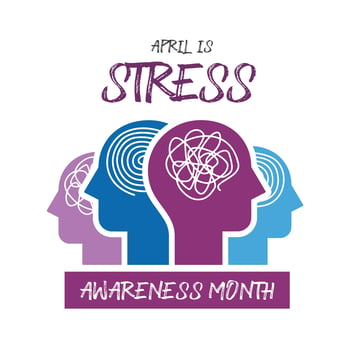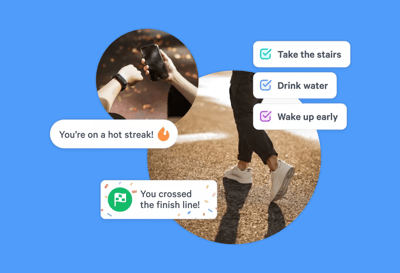April marks Stress Awareness Month, a crucial time for HR leaders in Australia to reemphasise the importance of mental and emotional wellbeing to their workforce, and the damaging ripple effects of stress. As workplaces evolve and adapt to new challenges, acknowledging, addressing and mitigating stress is paramount.
In Australia, work-related stress is a significant concern with 43% feeling stressed on a frequent basis, up from 38% in the previous year. HR leaders have a pivotal role to play in fostering a supportive environment and equipping employees with tools to manage stress effectively.
Let’s explore some strategies HR leaders can employ during Stress Awareness Month and beyond to promote a healthier workplace culture.
| Stress Awareness Month strategies (and beyond!) |
| 1. Implementing stress-reducing policies |
| 2. Open dialogue and education |
| 3. Promotion of work-life balance and holistic wellbeing |
| 4. Celebrating connection and collaboration |
1. Implementing stress-reducing policies
Reviewing existing policies and procedures to ensure they support employee wellbeing is essential. This may involve revising workload distribution, providing adequate resources and training, and establishing clear channels for conflict resolution and feedback. Policies promoting regular breaks, holiday leave utilisation and mental health days can also be beneficial.
Stress management is an ongoing process, and HR leaders should continuously evaluate the effectiveness of their initiatives and adapt them as needed. Soliciting feedback from employees through surveys or focus groups can provide valuable insights into areas for improvement.
Did you know that workplace concerns and stressors can have a huge impact on productivity and retention?
- Only 47% of employees feel productive. With a huge gap between Gen Z (35%) and Baby Boomers (65%);
- 43% feel frequently stressed and 34% frequently burnt out and overwhelmed;
- 43% say receiving recognition and reward is the number one driver of productivity for them;
- And only 23% of employees are actually feeling appreciated
2. Open dialogue and education
HR leaders should initiate open discussions about stress and its impact on individuals and the organisation as a whole. Providing educational resources on stress management techniques, mental health support services and encouraging employees to openly communicate about their stressors can help reduce stigma and foster a culture of support.
Partnering with mental health professionals or Employee Assistance Programs (EAPs) can provide employees with confidential support and counselling services. HR leaders should ensure that employees are aware of these resources and feel comfortable utilising them when needed. Additionally, training managers to recognise signs of stress and provide appropriate support and referrals is crucial.
3. Promotion of work-life balance and holistic wellbeing
Encouraging employees to prioritise work-life balance and their wellbeing outside of work is crucial and should be multi-faceted, from financial wellbeing to physical, emotional and social.
1. Financial
 Financial stress is one of the hardest to manage – money doesn’t grow on trees, after all. And with inflation hitting hard in Australia, high costs on everything from groceries and utilities to childcare and travel, employees are experiencing stress that a simple pay rise can’t solve on its own.
Financial stress is one of the hardest to manage – money doesn’t grow on trees, after all. And with inflation hitting hard in Australia, high costs on everything from groceries and utilities to childcare and travel, employees are experiencing stress that a simple pay rise can’t solve on its own.
So what’s an employer with limited resources to do? The best solution is to find cost-neutral or low-cost ways to help employees save money on essentials and luxuries, to stretch their dollars a bit further. Five or eight percent off might not seem like much at the moment, but those dollars add up faster than you think – and that money saved can be put toward anything your people need. Increasing employee buying power via an employee discounts platform (like the one Reward Gateway offers) comes with a small price tag, but yields a huge result.
If people are continually worried about their financial wellbeing it adds additional stress to both their work and personal lives, which reduces productivity. If you feel financially secure then you don't have to worry about feeding your family or paying bills and can focus on your job and home life. It gives you a better quality of life knowing that you can pay your bills. - Late Millennial, quoted in The Workplace Engagement Index
2. Physical
Physical activity and exercise have been shown to reduce stress and improve overall wellbeing. HR leaders can organise wellness challenges, provide access to fitness classes or gym memberships, and designate time in people's calendars to get outside and get active.
 Apps like MoveSpring offer physical activity challenges for employees to participate in together, such as a daily step count goal, staying active for 20 minutes each day – or anything that fits the unique interests of your workforce.
Apps like MoveSpring offer physical activity challenges for employees to participate in together, such as a daily step count goal, staying active for 20 minutes each day – or anything that fits the unique interests of your workforce.
Not only does this provide employees the opportunity to challenge themselves, but it provides them another avenue of communication and connection with their peers while they challenge each other to do even more.
Remember, if you're setting up one of these challenges, make sure it's inclusive and accessible! Offer accommodations and alternatives for people with disabilities or chronic illnesses who may need to move their bodies in differing ways.
3. Emotional
Emotional wellbeing is a huge topic, and typically the primary focus when discussing the effects of stress. There are countless ways people manage stress, from therapy and mindfulness to exercise and self-care, and there are workplace-friendly things we can do as well.
Partner with local mental health services to provide “wellbinars” for staff, especially if your organisation is undergoing any kind of significant change. These can be done as anonymous exercises, allowing staff to respond honestly to prompts without fear of judgement or pushback. It also helps staff see that they are not alone in anything they are feeling, as we are all more alike than we are different.
Consider implementing other wellness benefits at your organisation, such as discounts on gym memberships or even a general wellbeing stipend that employees can use how they see fit, whether that’s for exercise equipment or just a massage.
4. Celebrating connection and collaboration
Recognising and celebrating achievements, both big and small, can boost morale and alleviate stress. HR leaders can implement recognition programs, organise team-building activities or simply express gratitude for employees' hard work and dedication.
Our research found that almost 60% of Aussies have thought about leaving their job in the last six months, and of those staying less than half feel productive. Yet, 43% say receiving recognition and reward would help drive their productivity.

Reward Gateway uses eCards and peer-to-peer recognition to promote social and emotional wellbeing in the workplace. eCards allow us to recognise each other for our work, our successes and our friendships. It's about celebrating how we connect and collaborate with each other, while adding that positive uplift and morale boost that recognition and appreciation provides.
While stress management and support should be priorities every day, Stress Awareness Month provides HR leaders with a great opportunity to re-focus on what they can do to reduce their people's stress, boost wellbeing and improve engagement, productivity and retention.
For more content on how best to engage, connect and support your workforce, follow our blog and never miss an update.
 Kylie Green
Kylie Green


